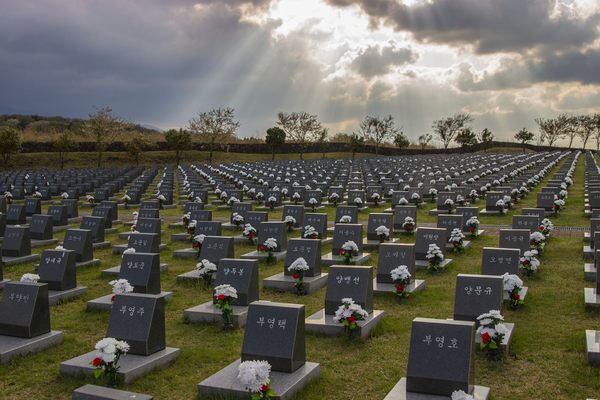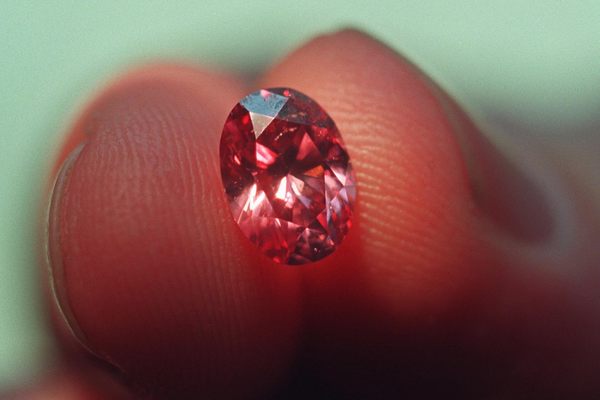
This Tank Graveyard Is a Monument to Eritrea’s Struggle for Liberation
With Eritrea and Ethiopia finally at peace, a massive military junkyard takes on new meaning.
A short distance from Asmara, the capital of Eritrea, lies a “tank graveyard”—a field littered with thousands of stacked military tanks, rusting trucks, and worn-out cars, remnants of a devastating, three-decade conflict with Ethiopia. Large cacti sprout within this steel maze, bearing orange and saffron-colored fruits. Children occasionally sneak their way into the graveyard, scooping up the fruit using long sticks topped with empty tin cans.
A man called Yonas takes shifts guarding over the site. (His name has been changed due to concerns for his safety.) Yonas doesn’t mind children coming in for the cactus fruit. Instead, he protects it from people who might steal scraps of metal, rubber, and other materials. Removing parts of the graveyard is akin to removing parts of Eritrean history, he says. And for him, Eritrea’s conflict-ridden history should be shared with everyone—especially now that the country has signed a historic peace declaration with Ethiopia.

Eritrea’s war of independence lasted from 1961 to 1991, and is one of Africa’s longest wars in recent memory. It killed over 125,000 soldiers on both sides. Yonas is himself a veteran of the conflict. “The graveyard is for all to witness what happened during the war with their own eyes,” he says. Yonas sees the site as a “memorial” to Eritrea’s unlikely victory against the larger, better-equipped army of Ethiopia.
The difference between the Eritrean and Ethiopian armies during the war was truly startling, according to Terrence Lyons, a professor of conflict resolution at George Mason University. “It really was peasant armies with sandals made out of tires and captured weapons, fighting against this army that had been supplied by the Soviet Union.”
The tank graveyard, Yonas explains, was meant to be an Ethiopian secret—but Eritreans exposed it for the world to see. During the war, Ethiopians would hide their destroyed military equipment just outside Asmara, knowing that leaving it on the streets would bolster Eritrean morale. After Eritrea’s victory in 1991, however, soldiers collected all the remaining machinery they could find, which was sprawled all across the country, and dumped it into the same site. It grew into a giant scrap-yard and public space.

Not all the war machinery could be collected, however. Yonas recounts stories of Eritreans losing limbs after treading on forgotten mines. “There’s more, it’s not all cleaned up,” he says. “There are areas that we can’t even reach by car that still have military equipment.” As more of this military hardware gets found, the graveyard may grow even larger.
The history of Eritrea is a history of domination and struggle. In 1882, Italians became the first Europeans to build settlements in Eritrea, during the colonialist “Scramble for Africa.” In 1941, the British, hoping to curtail Italy’s ever-expanding influence in the Horn of Africa, defeated Italian forces in the Battle of Keren. Many of the soldiers themselves came from colonized lands, such as Sudan and India.
The conflict freed Eritrea from Italian rule, but the nation’s landlocked neighbor, Ethiopia, had plans to take over. In 1952, the United Nations made Eritrea and Ethiopia a part of the same federation, and soon Eritreans began to fight back. In 1962, Haile Selassie, the Emperor of Ethiopia at the time, annexed Eritrea. In the 1970s, some Eritreans formed a Marxist liberationist movement called the Eritrean People’s Liberation Front.

Selassie was overthrown in 1974, and Yonas fought with the E.P.L.F. against the Soviet-backed regime that followed, known as the Derg. He still talks about the movement with pride. “We are strong, us Eritreans, very strong,” he says. “The Eritrean party that fought in the war was strong, invincible.”
Eritrea officially gained independence in 1993, after a landslide referendum. Isaias Afewerki, leader of the E.P.L.F. at the time, became president of Eritrea. “Isaias is a larger-than-life character and has been in Eritrean politics for decades now,” Lyons says. Afewerki may have led Eritrea to independence, but hostilities with Ethiopia continued. Back-and-forth border disputes escalated into a fully fledged war between 1998 and 2000, resulting in around 70,000 of deaths on both sides.
“This war created two separate realities,” says Tekeste Negash, a professor of history at Uppsala University. After the war, Eritrea’s staunch isolationism worsened poverty and inequality in the country, while Ethiopia soon became a booming economy. By 2018, the disparity between the two countries was so stark that the tank graveyard had lost its David-and-Goliath symbolism, says Negash. “The tank cemetery had lost all of its glory value. It faded completely.”

But then came a new era in the relations between Ethiopia and Eritrea. Since Abiy Ahmed became Prime Minister of Ethiopia, in April 2018, the two countries have forged peaceful diplomatic relations. For months, Eritreans and Ethiopians alike celebrated two peace agreements. And for the first time in two decades, a commercial airplane flew from Addis Ababa to Asmara, and telecommunication lines reopened.
Yonas is delighted to see Eritrea-Ethiopia relations improve. “We wanted peace with Ethiopia, and we’re happy that it has happened.” But some things will never change, he says. “Even if there is peace, history is the same.” To him, the tank graveyard serves as a reminder of the countless soldiers who lost their lives fighting for independence, and the relentlessness of Ethiopian forces. “The sheer amount of equipment shows how much they were willing to use to make Eritrea disappear.”
While many have watched with amazement as two former enemies embrace, dance, and offer gifts, others are suspicious. Eritrea-Ethiopian relations may have changed, but Afewerki’s dictatorial regime has not, comments William Davison, senior analyst on Ethiopia with International Crisis. “This is an autocracy, where a lot of the decisions are made by the president and some key advisors, ministers, generals—it’s a very small circle.” Around 12 percent of Eritrea’s population has fled the country, largely to avoid repressive policies.

To many of those who have escaped Eritrea, the tank graveyard is a dark symbol. “This against-all-odds narrative makes me sad because most of the people who fought are now in prisons,” says Meron Estefanos, a human rights activist and journalist. Estefanos says they were imprisoned for demanding reforms after independence. “The tank graveyard is a reminder of injustice in Eritrea.” The country still has no constitution, exercises full control over its media and, by 2013, had arrested at least 10,000 political prisoners without charge or trial.
Perhaps the real reason Eritrea and Ethiopia have come together is to defeat a mutual enemy, says Kjetil Tronvoll, director of peace and conflict studies at Bjorknes University College: the Tigray People’s Liberation Front. Tigray is a region that borders Eritrea, and the T.P.L.F. has amassed vast wealth and a strong military force there.
Meanwhile, Negash, the historian, suspects that warming relations between the former rivals mask a hushed plan to reunite Eritrea and Ethiopia. He believes unification is all the more likely considering the deep sense of identity Eritreans and Ethiopians share.

The tank graveyard’s symbolism is not static, says Lyons, the George Mason professor. It is constantly changing as history unfolds. “The armed struggle will have to be re-taught, re-learned, and the story will have to be re-told so that the tank graveyard takes on a different meaning,” he says. And as Eritreans who fought the war are replaced by a new generation, he goes on, the tank graveyard will “help them make sense of who they are and where their country came from.” To Negash, the tank graveyard epitomizes Eritrean independence; if Eritrean-Ethiopian borders really were to dissolve, he says, the graveyard’s symbol as a beacon of Eritrean independence would dissolve too.
In years to come, the symbolism of the tank graveyard will be in the hands of every Eritrean, including generations that will not remember the conflict with Ethiopia. But for now, there are those, like Yonas, who will tell the story of what it has meant over the years, and where it came from. “It makes you remember everything that we went through—the war, the young who died in combat,” he says. Yonas won’t forget his country’s painful history, but he’s relieved that Eritrea-Ethiopia relations have entered a new era. “There is peace now.”
You can join the conversation about this and other stories in the Atlas Obscura Community Forums.















Follow us on Twitter to get the latest on the world's hidden wonders.
Like us on Facebook to get the latest on the world's hidden wonders.
Follow us on Twitter Like us on Facebook